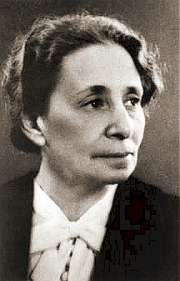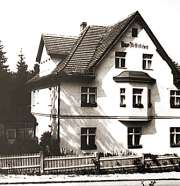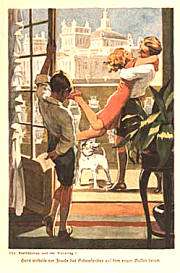 The first English translation of the
most popular book by the beloved German Jewish children's author, who was
murdered at Auschwitz in 1943.
The first English translation of the
most popular book by the beloved German Jewish children's author, who was
murdered at Auschwitz in 1943.
![]()
Nesthäkchen and the World War
by
Else Ury
Translated from the German, annotated, and introduced by Steven Lehrer
This Nesthäkchen story of a pre-adolescent
girl growing up in Berlin at the outbreak of World War I presents a
charming, skillful evocation of a long-vanished world.
 A recent survey of German women revealed that 55%
had read Else Ury's
Nesthäkchen books. Even more had heard them read over the
radio or had seen the
television serialization. These stories show an ordinary
girl growing up, and attempt to explain to children why a girl is so different
from a boy, and so interesting too. At the end of the tenth volume of the
series, the delighted reader comes away with the answer: Girls aren't so
different. Nesthäkchen's adventures had another attraction for children. They
were more factual and showed more of daily life than did other children's
stories of the time. There was plenty of conflict, yet it was good natured and
funny. Even the worst situations had agreeable resolutions.
A recent survey of German women revealed that 55%
had read Else Ury's
Nesthäkchen books. Even more had heard them read over the
radio or had seen the
television serialization. These stories show an ordinary
girl growing up, and attempt to explain to children why a girl is so different
from a boy, and so interesting too. At the end of the tenth volume of the
series, the delighted reader comes away with the answer: Girls aren't so
different. Nesthäkchen's adventures had another attraction for children. They
were more factual and showed more of daily life than did other children's
stories of the time. There was plenty of conflict, yet it was good natured and
funny. Even the worst situations had agreeable resolutions.
But like the popular Wild West books of German author Karl May, the Nesthäkchen
books have not traveled well. Else Ury tried but failed to have her own English
translation published in the late 1930's. (Her English was not very good.) A Dutch translation a few years
earlier was hardly more successful. Yet in Germany, the
Nesthäkchen series is a perennial best seller. As of 1992, seven million copies
were in print. German bookstores invariably reserve a special rack in the
children's department for Ury's Nesthäkchen books.
Else Ury was born in Berlin, November 1, 1877, the third child of third
generation Berlin merchant Jews. Her large, well-to-do, close-knit bourgeois
family provided a loving environment. The experiences of her own happy
childhood, as well as her observation of the growth of her sisters, brothers,
nephews, and nieces, inspired Else Ury to later write her family and youth
books.
 Her grandfather, Levin Elias Ury, was director of the Synagogue in the
Heidereutergasse in central Berlin. Her parents, who lived in Charlottenberg,
were no more religious than most of the Christians in the neighborhood. But the
Urys never hid their Jewish origins.
Her grandfather, Levin Elias Ury, was director of the Synagogue in the
Heidereutergasse in central Berlin. Her parents, who lived in Charlottenberg,
were no more religious than most of the Christians in the neighborhood. But the
Urys never hid their Jewish origins.
One older brother, Ludwig, studied law, while another, Hans, studied medicine,
and Else's younger sister Käthe became a teacher. Although women's needs for
education and a profession to secure independence were later a recurring theme
in her books, Else Ury herself pursued no professional studies.
In 1900 Else Ury began publishing travel reports and stories in the Vossiche
Zeitung, a Berlin newspaper, under a pen name. Because a father was supposed to
support his unmarried daughters, if a girl still living at home earned money by
writing, social convention forced her to disguise her identity.
Else's father, Emil Ury, was a tobacco products manufacturer, who produced snuff
and chewing tobacco. When cigarette popularity soared around the turn of the
century, snuff and chewing tobacco sales declined precipitously. Faced with
economic ruin, Emil Ury tried to prevail upon Else to marry the son of a rich
cigarette manufacturer, with the hope that a merger of the two family companies
would follow. But Else resisted this scheme, and remained single her entire
life.
In 1906 Else Ury had her first modest literary success with Educated Girls,
a novel dealing with the very controversial subject of higher education for
women. Indeed, regular women's university studies were first permitted in
Prussia only in 1908. Although Emil Ury's business had gone bankrupt, Else was
able to help support her family with book royalties.
Her breakthrough to bestseller status came with her Nesthäkchen books. Germans
call a spoiled child or family pet a Nesthäkchen. Else Ury's Nesthäkchen is a
Berlin doctor's daughter, Annemarie Braun, a slim, gorgeous, golden blond,
quintessential German girl. The ten book series follows Annemarie from infancy (Nesthäkchen
and Her Dolls) to old age and grandchildren (Nesthäkchen with White Hair).
Despite Else Ury's Jewish background, she makes no references to Judaism in the
Nesthäkchen books.
Nesthäkchen and the World War (1916), the fourth and most popular volume
in the series, sold 300,000 copies. Else Ury wrote the fifth and sixth volumes,
Nesthäkchen's Teenage Years, in 1919, and Nesthäkchen Flies From the
Nest in 1923. She intended to stop there, with Nesthäkchen's marriage, but
her readers simply wouldn't let her. Distraught girls inundated her Berlin
publisher, Meidingers Jugendschriften Verlag, with a flood of letters pleading
for more Nesthäkchen stories. Else Ury obliged her young fans with four more
Nesthäkchen books.
On November 1, 1927, Else Ury's fiftieth birthday, Meidingers Jugendschriften
Verlag gave her a large reception, and announced the publication of an
expensively bound new edition of all ten Nesthäkchen books. The series had been
an immense success, and even the head of the company, Kurt Meidinger, was on
hand to praise Else Ury and her work. The Adlon Hotel, the most elegant in
Berlin, catered the affair, which was attended by many reporters, and chronicled
in German newspapers the next day. In the meantime, Meidingers had established a
special post office box for Nesthäkchen correspondence. Readers sent both
letters and pictures they had drawn for the stories. Else Ury answered all mail
monthly and, from time to time, held parties for her Nesthäkchenkinder, with
cake and chocolate, in the garden of her house. Many of the parties were the
subject of newspaper stories.
 Despite
her literary success, Else Ury lived quietly, and didn't consider the details of
her own life to be especially noteworthy. In 1926, with money from her books,
she bought a vacation house in the Riesengebirge area of Krummhübel, which she
named "House Nesthäkchen." Here she and her family spent many summer and winter
vacations.
Despite
her literary success, Else Ury lived quietly, and didn't consider the details of
her own life to be especially noteworthy. In 1926, with money from her books,
she bought a vacation house in the Riesengebirge area of Krummhübel, which she
named "House Nesthäkchen." Here she and her family spent many summer and winter
vacations.
In Else Ury's last book, Youth to the Fore, published in 1933, the author
tried to put a good face on Hitler's rise to power. The book dealt with
overcoming the economic crisis and unemployment, restoring order with a firm
hand, and strengthening Germany. No one is certain whether Ury was politically
naive and had been seduced by Nazi propaganda, or whether her publisher, to
please the regime, had obediently altered the text.
As a Jew, Else Ury was excluded from the Reich Chamber of Writers in 1935, which
meant she was no longer allowed to publish. By 1936, most of her relatives had
emigrated, and her brother Hans had committed suicide. She herself did not want
to leave Germany, because she had to care for her 90 year old mother, Franziska,
who in photographs bears a remarkable resemblance to Sigmund Freud's mother,
Amalie. Else Ury traveled to London, in 1938, for a short visit to her nephew,
Klaus Heymann, but ignored his pleas for her to stay in England. She returned to
Berlin and remained until the Nazis deported her. Her mother died in 1940.
Until 1933, Else Ury lived in Kantstraße 30, then at Kaiserdamm 24. In 1939 she
was forced to move to a "Jew house," a former Jewish old age home in
Solingerstraße 10, where the Gestapo collected Jews for deportation. On January
6, 1943, she had to fill out a declaration of all her possessions, and with one
valise and a few articles of clothing, report for resettlement. She was ordered
to present herself at a collection point, Großer Hamburgerstraße 26, to wait for
transport. On January 11, 1943, she signed a release, turning over all her
property to the German Reich. German officials proceeded to sell off everything
she owned.
On January 12, 1943, the 65-year-old Else Ury was taken to the railroad station
at Berlin Grunewald, along with 1,190 other Berlin Jews, packed into a boxcar,
and deported to Auschwitz-Birkenau. A day later, SS doctors selected 127 men
from her transport for labor. SS guards murdered Else Ury and the other Jews in
the gas chamber.
After 1945, Else Ury's books were heavily edited and many contemporaneous or
historical references removed. In 1983, there was a six-part television
serialization of the Nesthäkchen books. Finally, half a century after her death,
her millions of women readers learned the details of her dreadful fate.
A group of high school students from the Robert Blum Gymnasium in
Berlin-Schöneberg discovered the exact date of Else Ury's death on a visit to
Auschwitz in 1995. They also found there her battered valise, labeled with her
name and Berlin address. The valise and other objects and documents relating to
her life were exhibited in Berlin until 2002, when they were returned to the
museum at Auschwitz. They are heartbreaking to see.
Of all the millions of murders the Nazis committed, Else Ury's stands out. Could
anyone imagine the British murdering AA Milne a few years after he had written
Winnie the Pooh?
Nesthäkchen and the World War
 Nesthäkchen
and the World War is a difficult book for Germans. After World War II it was
not republished with the other nine Nesthäkchen volumes. The Meidingers
catalogue stated that the book was not a war story or a “hurrah tale.” But it is
by no stretch of the imagination an anti-war book, either.
Nesthäkchen
and the World War is a difficult book for Germans. After World War II it was
not republished with the other nine Nesthäkchen volumes. The Meidingers
catalogue stated that the book was not a war story or a “hurrah tale.” But it is
by no stretch of the imagination an anti-war book, either.
With the country nothing but a heap of rubble in 1945, the Germans wanted no
more to do with the sentiments that had brought them to such a pass. High on the
list were love for the fatherland, exaggerated respect for the military, and
enthusiasm for war.
These sentiments were easy to excise from most of the Nesthäkchen books. For
example, in Nesthäkchen in the Children’s Sanatorium, the volume
preceding Nesthäkchen and the World War, Else Ury describes a German
submarine, which Annemarie watches as it disappears underwater.
"Then it was certainly a submarine, Annemarie," says a companion, "that can dive
and remain submerged for hours without anyone seeing it. We discovered the
submarine to be a weapon for war at sea. God grant that we will never need to
use it." In the revised version
of Nesthäkchen in the Children’s Sanatorium issued in 1950, the submarine
is not mentioned.
But no amount of rewriting could ever remove all objectionable material from
Nesthäkchen and the World War, as it is too integral to the plot. Despite
its enormous prewar success, no German language publisher would touch this
volume.
Else Ury never caught on in the English speaking world, most likely because when
she was at the height of her popularity, either the Germans were our blood
enemy, or the carnage of World War I was too recent for anyone to want to read
about the mind-set of the people who initiated it. Today, though, Else Ury’s
books, particularly Nesthäkchen and the World War, present a charming
evocation of a long-vanished time and place. Germany, a solid democracy, has
been our friend and staunch ally for more than half a century. A modern reader feels deep sympathy for the
trusting, good-hearted, generous people whom a fatuous Kaiser and a pack of
bungling, inept diplomats had thrust into a horrific war. Moreover, Else Ury’s
love for Germany now seems quite poignant and sad, in light of what happened to
her.
The depiction of Nesthäkchen’s abuse of Vera, a Polish-speaking refugee child
whom the author introduces in Chapter 10 of Nesthäkchen and the World War, is
quite upsetting to some German readers. Nesthäkchen mercilessly excludes the
kindly, pathetic Vera from her group and turns her into a school pariah.
In fact, Else Ury has rendered Nesthäkchen as a more believable character
because of her treatment of Vera. Nesthäkchen’s mean streak makes her quite
human. And of course, schoolchildren similarly brutalize each other today,
especially their peers who cannot conform to group pressure, witness the
Columbine High School massacre. Enid Blyton, the English children’s writer with
whom Else Ury is frequently compared, and who is very popular with German girls,
depicts situations analogous to Vera’s.
More important, the device is indispensable for the development of the plot and
leads to the shocking, ringing climax in Chapter 16, one of the most moving
sections of the entire book. Else Ury also skillfully employs exposition and
plot to develop scenes that are laugh-out-loud funny, followed by others that
are highly melodramatic. Nesthäkchen and the World War holds the reader’s
attention from beginning to end. It is not surprising that it was the most
popular volume in the series.
And the book conveys a timeless
lesson, for children as well as adults, about the nature of war. Wars often
begin with a terrific outpouring of patriotic sentiment. World War I started
this way, and Else Ury's description of German war-euphoria in 1914 is chilling.
But Nesthäkchen quickly comes to recognize the hardships and horrors of war, the
dislocations, the pathetic refugees, the scarcity of food, the combat deaths of
favorite teachers, relatives, and friends. In All Quiet on the Western Front,
Erich Maria Remarque describes World War I more horrifically, but he was
writing from the battlefield. Ury's depiction of the war as seen from Berlin,
though gentler, is as powerful as Remarque's. When Nesthäkchen and the World War
ends, in mid 1916, battle had become mass slaughter. Else Ury, unlike Remarque,
simply could not bear the pain of writing about it further.





